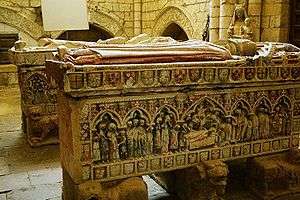Inés Rodríguez Girón
Inés Rodríguez Girón (died in 1265) was infanta of the Kingdom of Castile as the second wife of Infante Philip of Castile.
| Inés Rodríguez Girón | |
|---|---|
 Tombs of Infante Philip and Infanta Inés | |
| Died | 1265 Seville |
| Burial | |
| Spouse | Infante Philip of Castile |
| House | House of Girón |
| Father | Rodrigo González Girón |
| Mother | Teresa López de Haro |
| Religion | Roman Catholicism |
Biography
Her parents were Rodrigo González Girón, Lord of Frechilla, and his second wife, Teresa López de Haro. Her maternal grandparents were Lope Díaz II de Haro and Urraca Alfonso, the illegitimate daughter of King Alfonso IX of León. Inés married her mother's second cousin, Infante Philip, in 1263 or 1264, after the death of his first spouse, Christina of Norway, becoming Lady of Valdeporchena, Piedrahita and Valdecorneja. The couple had no children. Infanta Inés died in Seville in 1265 and her husband remarried, his third wife being Leonor Rodríguez de Castro.[1]
She is buried in Villalcázar de Sirga, in the Church of Santa María la Blanca. Her husband, who died in 1274 predeceasing his third wife, is buried next to her, in a larger tomb. The remains of both rested in two tomb, placed in the choir of the church, but today the two tombs are placed in the chapel of Santiago.[2]
The tomb containing the remains of Inés Rodríguez Girón is smaller than the one containing the remains of her husband. The style shows that both were done at the same time. The tomb only has sculpture work on the sides, but not at the head or feet. On the lid of the tomb appears a recumbent statue representing the deceased. Ines Rodriguez's head rests on three pillows, like that of her husband.[3]
Ancestry
| Ancestors of Inés Rodríguez Girón[1] | ||||||||||||||||||||||||||||||||||||||||||||||||||||||||||||||||||||||||||||||||||||||||||||||||||||||||||||||||||||||||||||||||||||||||||||||||||||||||||||||||||||||||||||||||||||||||||||||||||||||||||||||||||||||||||||||||||||||||||||||||||||||||||||||||||||||||||||||||||||||||||||||||||||||||||||||||||||||||||||||||||||||||||||||||||||||||||||||||||||||||||||||||||||||||||||||||||||||||||||||||||||||||||||||||||||||||||||||||||||||||||||||||||||||||||||||||||||||||||||||||||||||||||||||||||||||||||||||||||||||||||||||||||||||||||||||||||||||||||||||||||||||||||||||||||||||||||||||||
|---|---|---|---|---|---|---|---|---|---|---|---|---|---|---|---|---|---|---|---|---|---|---|---|---|---|---|---|---|---|---|---|---|---|---|---|---|---|---|---|---|---|---|---|---|---|---|---|---|---|---|---|---|---|---|---|---|---|---|---|---|---|---|---|---|---|---|---|---|---|---|---|---|---|---|---|---|---|---|---|---|---|---|---|---|---|---|---|---|---|---|---|---|---|---|---|---|---|---|---|---|---|---|---|---|---|---|---|---|---|---|---|---|---|---|---|---|---|---|---|---|---|---|---|---|---|---|---|---|---|---|---|---|---|---|---|---|---|---|---|---|---|---|---|---|---|---|---|---|---|---|---|---|---|---|---|---|---|---|---|---|---|---|---|---|---|---|---|---|---|---|---|---|---|---|---|---|---|---|---|---|---|---|---|---|---|---|---|---|---|---|---|---|---|---|---|---|---|---|---|---|---|---|---|---|---|---|---|---|---|---|---|---|---|---|---|---|---|---|---|---|---|---|---|---|---|---|---|---|---|---|---|---|---|---|---|---|---|---|---|---|---|---|---|---|---|---|---|---|---|---|---|---|---|---|---|---|---|---|---|---|---|---|---|---|---|---|---|---|---|---|---|---|---|---|---|---|---|---|---|---|---|---|---|---|---|---|---|---|---|---|---|---|---|---|---|---|---|---|---|---|---|---|---|---|---|---|---|---|---|---|---|---|---|---|---|---|---|---|---|---|---|---|---|---|---|---|---|---|---|---|---|---|---|---|---|---|---|---|---|---|---|---|---|---|---|---|---|---|---|---|---|---|---|---|---|---|---|---|---|---|---|---|---|---|---|---|---|---|---|---|---|---|---|---|---|---|---|---|---|---|---|---|---|---|---|---|---|---|---|---|---|---|---|---|---|---|---|---|---|---|---|---|---|---|---|---|---|---|---|---|---|---|---|---|---|---|---|---|---|---|---|---|---|---|---|---|---|---|---|---|---|---|---|---|---|---|---|---|---|---|---|---|---|---|---|---|---|---|---|---|---|---|---|---|---|---|---|---|---|---|---|---|---|---|---|---|---|---|---|---|---|---|---|---|---|---|---|---|---|---|---|---|---|---|---|---|---|---|---|---|---|---|---|---|---|---|---|---|---|---|---|---|---|---|---|---|---|---|---|---|---|---|---|---|---|---|---|---|---|---|---|---|---|---|---|---|---|---|---|---|---|---|---|---|---|---|---|---|---|---|---|---|---|---|---|---|---|---|---|---|---|---|---|---|---|---|---|---|---|---|---|---|---|---|---|---|---|---|---|---|---|---|---|---|---|---|---|---|---|---|---|---|---|---|---|---|---|---|---|---|---|---|
| ||||||||||||||||||||||||||||||||||||||||||||||||||||||||||||||||||||||||||||||||||||||||||||||||||||||||||||||||||||||||||||||||||||||||||||||||||||||||||||||||||||||||||||||||||||||||||||||||||||||||||||||||||||||||||||||||||||||||||||||||||||||||||||||||||||||||||||||||||||||||||||||||||||||||||||||||||||||||||||||||||||||||||||||||||||||||||||||||||||||||||||||||||||||||||||||||||||||||||||||||||||||||||||||||||||||||||||||||||||||||||||||||||||||||||||||||||||||||||||||||||||||||||||||||||||||||||||||||||||||||||||||||||||||||||||||||||||||||||||||||||||||||||||||||||||||||||||||||
Notes
- Cawley, Charles, Genealogy of Inés Rodríguez Girón, Medieval Lands database, Foundation for Medieval Genealogy,
- Suárez Smith, Covadonga; Rosa María de los Santos Rodríguez (1997). "Investigación museológica acerca de los fragmentos de tejido pertenecientes a la capa del infante Don Felipe (s. XIII)". Boletín de la ANABAD. 47 (1). Madrid: Confederación de Asociaciones de Archiveros, Bibliotecarios, Museólogos y Documentalistas, ANABAD. pp. 161–162. ISSN 0210-4164.
- Del Arco y Garay, Ricardo (1954). "XIV". In Instituto Jerónimo Zurita. Consejo Superior de Investigaciones Científicas (ed.). Sepulcros de la Casa Real de Castilla. Madrid. p. 220.
Bibliography
- Del Arco y Garay, Ricardo (1954). Instituto Jerónimo Zurita. Consejo Superior de Investigaciones Científicas. (ed.). Sepulcros de la Casa Real de Castilla. Madrid.
- De Loaysa, Jofré; García Martínez, Antonio (1982). Academia Alfonso X el Sabio, Colección Biblioteca Murciana de bolsillo Nº 27 (ed.). Crónicas de los Reyes de Castilla Fernando III, Alfonso X, Sancho IV y Fernando IV (1248-1305). latín y castellano (2ª ed.). Murcia. ISBN 84-00-05017-7.
- Rubio Salán, Antonio (1952). "Breve noticia de Villalcazar de Sirga y de su Templo". Publicaciones de la Institución Tello Téllez de Meneses (8). Palencia: Institución Tello Téllez de Meneses. pp. 27–48. ISSN 0210-7317.
- Salazar y Mendoza, Pedro de; Soria Mesa, Enrique; Carrillo, Alonso (1998). Universidad de Granada (ed.). El origen de las dignidades seglares de Castilla y León (1ª ed.). Granada. ISBN 84-338-2453-8.
- Ybarra y López-Dóriga, Fernando de, Marqués de Arriluce de Ybarra (1997). Real Academia Sevillana de Buenas Letras (ed.). Un largo siglo de amores y desamores en el Alcázar de Sevilla (1248-1368) (1ª ed.). Sevilla. ISBN 84-8093-016-0.
External links
- Cawley, Charles, Genealogy of Inés Rodríguez Girón, Medieval Lands database, Foundation for Medieval Genealogy